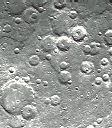 | A view of Mercury (courtesy NASA/JPL/Northwestern University) |
Mercury is closest planet to Sun in the solar system, orbiting 36 million miles from our star. It remained few known until space age as this planet as seen from Earth is always low on the horizon and not easily observable. A first comprehensive space age view of Mercury was given by NASA craft Mariner 10 which was launched in November 1973 and reached Mercury after two flybys at Venus -being then the first craft to perform a gravity assist trajectory. Mariner 10 provided 12,000 pictures, mapping about 45 percent of the planet. Mercury is 3202 miles wide (i.e. one third more than Moon and a little less than Earth's half). Mercury orbits the Sun in 88 days. As Sun progressively slowed its self-rotation, the latter became locked with the revolution period leading to a Mercury day at Mercury lasting 175 days. Mercury is very similar to our Moon. Its surface is mainly made of craters of various sizes and ages, of basins, and of lava flows. One of Mercury main feature is Caloris Basin, 807 mi (1300) km wide which was created by an impactor larger than 62 mi (100 km). Ejecta were sent up to 600-800 km away. Another characteristic of Mercury are its long and tall faults which formed when planet cooled and retracted. Some plains are less cratered due to lava flows. Mercury soil, like Moon's was progressively covered with regolith produced by micrometeorites striking the surface. Mercury has mostly no atmosphere (what exists is 42 percent helium, 42 percent sodium and 15 percent oxygen). It has a magnetic field about 1 percent that of Earth. This might point to Mercury having a molten core yielding a dynamo process but that might be due as well to remnant magnetism emanating from iron-bearing rocks once magnetized by a stronger magnetosphere. Mercury has a high density (5.44 g/cm3). Like what is hypothesized about Moon, Mercury might have some water-ice at one of its poles. Water might have originated from planet outgasing or have been brought by comets. Temperatures at Mercury are varying between 427 ° C, and - 173° C
One benefit of the mission is that, as Earth, Venus, and Mars have been well explored, Messenger will complete the data at Mercury. Thus scientists will better undestand what processes most had the inner planets turn out different after they had a period of similar formation
Results Returned En Route
Results Returned From the Orbit
| During its long, 7-year journey to Mercury, MESSENGER has sent science results. check MESSENGER results returned en route |
![]() Results Returned From the Orbit
Results Returned From the Orbit
| Since April 2011, MESSENGER is working about Mercury from orbit. ccheck MESSENGER results returned from the orbit |